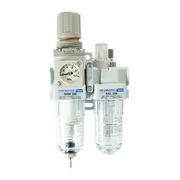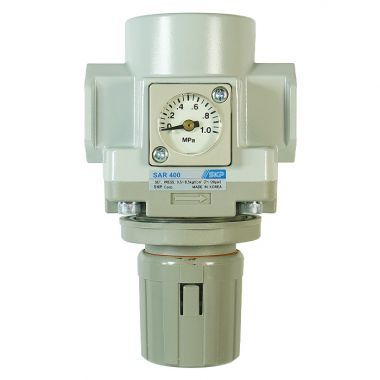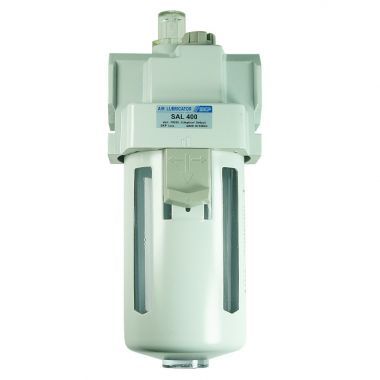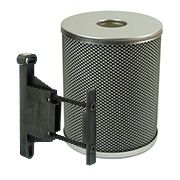Air treatment - why is it worth it?
Compressed air is currently used in industry to drive many pneumatic devices, but it must meet high quality requirements to ensure trouble-free operation of the equipment. Air-powered devices usually react poorly to excessively high compressed air temperature, its humidity or contamination.
Treatment of compressed air in the pneumatic system is necessary to achieve quality parameters depending on the specificity of the industry and the requirements of the manufacturer of end devices. Adapting to these requirements allows you to maintain high quality and efficiency of devices for a long time.
The basic device supplying pneumatic equipment is a compressor. The air compressor is equipped with an air filter (usually with an accuracy of 10 µm), which does not guarantee sufficient protection for the devices connected to it. The filter blocks air pollution particles from getting into the supply system, however, it is no longer able to neutralize dust particles with a smaller diameter than the specification of the filter used.
An additional undesirable effect that occurs in the supply device is the suction of moisture in the form of water vapor from the atmosphere. The compressor collects hazardous compounds which are transferred via the carrier route to the pneumatic devices. They have a negative effect on the supplied equipment, causing, among other things, corrosion and uneven operation.
Compressed air filtration - types
Compressed air can be cleaned by additional filters or air treatment plants. Contamination from the air produced by the compressor is removed by a compressed air filter, which is a pressure device. Filters ensure the correct operation of pneumatic devices.
There are four types of filters:
- dust
- carbon
- sterile
- coalescing
Particulate matter is removed from the compressed air via a dust filter. They can be divided into two types: coarse and fine, depending on the degree of filtration. Particulate matter in the compressed air is retained in the filter element.
The following phenomena help catch and contain solids:
- sieve effect - particles above 10 microns are retained and immobilized
- inertial collisions - applies to particles above 5 microns and high gas velocities, if the air flow changes direction and the particle is too heavy to adapt to it, it hits the fiber and stops.
- interception - particles above 0.1 microns are captured in this way, this phenomenon occurs when the particle moves through the fibers of the cartridge, but does not follow the air current, and its radius is greater than the distance between the streamline and the circumference of the fiber.
- diffusion - otherwise known as " Brownian motion ", refers to the smallest particles, less than 0.3 microns in size, tend to move erratically, colliding with each other, resulting in accidental capture by the filter.
Odors and oil vapors are removed by means of carbon filters, the cartridge of which is filled with activated carbon, and filtration is based on adsorption. Compressed air flows through the filter cartridge from the inside to the outside, and then reaches the porous outer surface of the cartridge, which prevents the penetration of dust, generated in the process of filtration by activated carbon.
Microorganisms and solid particles are removed using sterile filters. The housings of such filters are made of stainless steel, which makes it possible to sterilize the filter cartridge and housing at the place of its work. Filtration takes place either by retention or by membranes. Sterilization procedures should be repeated periodically while using the sterile filter.
Coalescing filters remove water, oil aerosols and solid particles from compressed air. Purification of compressed air from solid particles is carried out in the same way as in dust filters, while the removal of water or oil aerosols is achieved thanks to coalescence. The filter combines liquid aerosols into larger droplets, which then fall to the bottom of the filter and are collected in the lower part of the filter housing to be removed through the drain.
About compressed air treatment
Filters, and more specifically filter inserts, should be replaced at least once a year. A filter used for a longer period of time loses its filtration properties. Replacing the filter element is simple and inexpensive, and ignoring the recommendations can lead to much higher and more serious costs. In the case of carbon filters or, in the case of a pressure drop of up to 0.35 bar, it all depends on the purity level of the compressed air.
It becomes unprofitable to use the filter when the value of the energy loss is 0.35 bar and more. The pressure loss value on filters and dryers should be checked. Clean compressed air guarantees that the pneumatic devices and control systems will work flawlessly for a long time. As a result, the maintenance and repair costs of the device are reduced.
Air treatment plant - is it worth the investment?
A popular element that can be used in a pneumatic installation is an air treatment station . It is a device consisting of several blocks connected to each other, each of which performs a different function. The three most popular elements of the station are the filter, reducer and lubricator, but the stations can also use dryers, oil separators, quick-start valves and others.
The blocks are part of the kit that removes solid and liquid contaminants in appropriate amounts according to the filter insert used. The station is also used to set and maintain a constant value of the output pressure in pneumatic installations, regardless of the higher inlet pressure.
The pressure control valve , i.e. the compressed air regulator, is usually set manually (pneumatic, electronic control, etc. is possible). The compressed air reducer (or, more precisely, its measuring system) takes the energy necessary to work from the medium and generates a force that is sufficient to move the actuating element.
These devices consist of a spring, a needle and a diaphragm, which, depending on the pressure increase, closes or opens the valve, regulating the pressure of compressed air, so that the system maintains a constant level. Too much or too little pressure can damage or malfunction the machine or end device.
There are the following types of reducers:
- pressure reducer up to 16 bar, works well in every pneumatic installation
- precision reducer up to 16 bar, regulates the pressure very precisely, allows to obtain low pressures, has no influence on the compressed air throughput, adjustment accuracy is not affected by a change in the supply pressure
- high pressure reducer up to 40 bar, used at high pressures, is very stable and durable, eliminates shocks
- High-flow reducer, reduces pressures at flows above 12,500 l / min, is usually used in heavy industry.
The air treatment station is equipped with an oil dispenser, the operation of which is aimed at saturating the air supplying the receivers requiring lubrication with oil. Lubricators take care of the devices and protect them against damage by introducing oil mist to the compressed air system.








Login and Registration Form